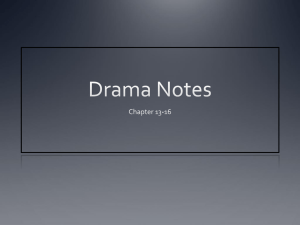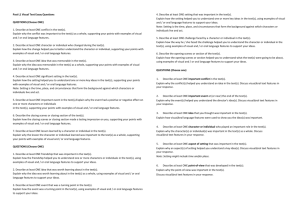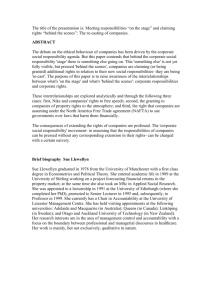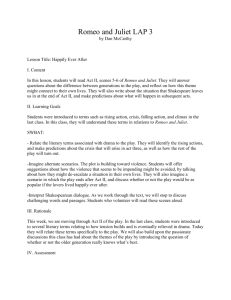Propositions
advertisement
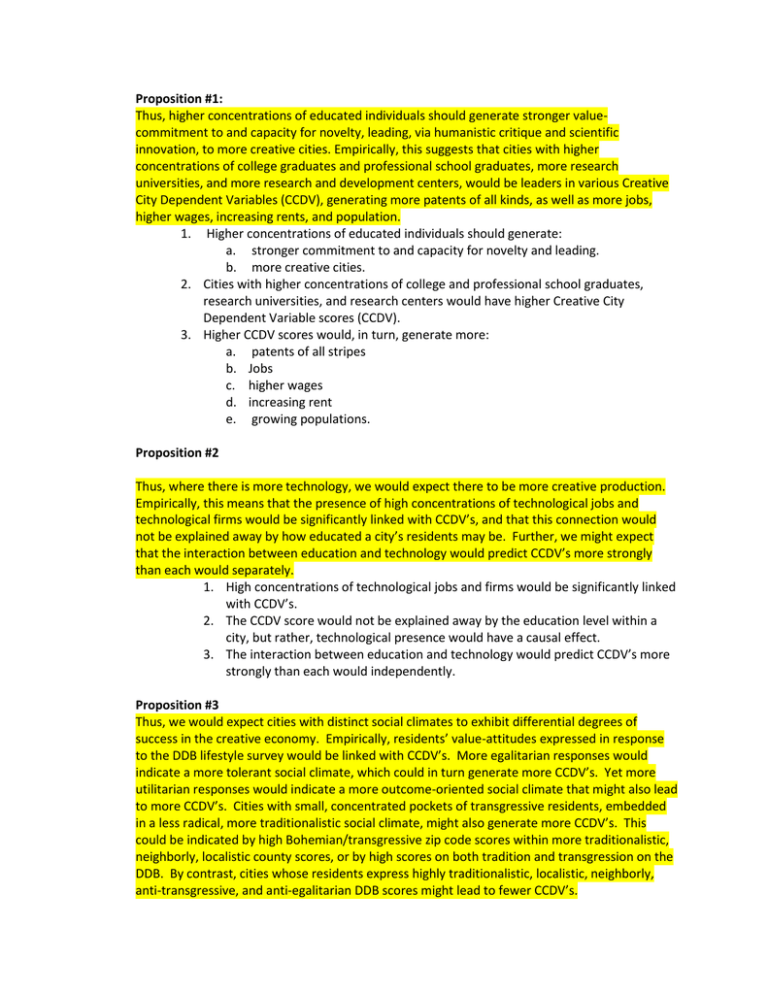
Proposition #1: Thus, higher concentrations of educated individuals should generate stronger valuecommitment to and capacity for novelty, leading, via humanistic critique and scientific innovation, to more creative cities. Empirically, this suggests that cities with higher concentrations of college graduates and professional school graduates, more research universities, and more research and development centers, would be leaders in various Creative City Dependent Variables (CCDV), generating more patents of all kinds, as well as more jobs, higher wages, increasing rents, and population. 1. Higher concentrations of educated individuals should generate: a. stronger commitment to and capacity for novelty and leading. b. more creative cities. 2. Cities with higher concentrations of college and professional school graduates, research universities, and research centers would have higher Creative City Dependent Variable scores (CCDV). 3. Higher CCDV scores would, in turn, generate more: a. patents of all stripes b. Jobs c. higher wages d. increasing rent e. growing populations. Proposition #2 Thus, where there is more technology, we would expect there to be more creative production. Empirically, this means that the presence of high concentrations of technological jobs and technological firms would be significantly linked with CCDV’s, and that this connection would not be explained away by how educated a city’s residents may be. Further, we might expect that the interaction between education and technology would predict CCDV’s more strongly than each would separately. 1. High concentrations of technological jobs and firms would be significantly linked with CCDV’s. 2. The CCDV score would not be explained away by the education level within a city, but rather, technological presence would have a causal effect. 3. The interaction between education and technology would predict CCDV’s more strongly than each would independently. Proposition #3 Thus, we would expect cities with distinct social climates to exhibit differential degrees of success in the creative economy. Empirically, residents’ value-attitudes expressed in response to the DDB lifestyle survey would be linked with CCDV’s. More egalitarian responses would indicate a more tolerant social climate, which could in turn generate more CCDV’s. Yet more utilitarian responses would indicate a more outcome-oriented social climate that might also lead to more CCDV’s. Cities with small, concentrated pockets of transgressive residents, embedded in a less radical, more traditionalistic social climate, might also generate more CCDV’s. This could be indicated by high Bohemian/transgressive zip code scores within more traditionalistic, neighborly, localistic county scores, or by high scores on both tradition and transgression on the DDB. By contrast, cities whose residents express highly traditionalistic, localistic, neighborly, anti-transgressive, and anti-egalitarian DDB scores might lead to fewer CCDV’s. 1. More egalitarian responses would generate higher CCDV’s. 2. More utilitarian responses would generate CCDV’s. 3. Cities with small, concentrated pockets of transgrassive residents embedded in a less radical, more traditionalistic social climate (such as Wicker Park in Chicago’s north side), might also generate more CCDV’s. a. This phenomenon could be indicated by high Bohemian/transgressive zip code scores within more traditionalistic, neighborly, localistic country scores. It could also be indicated by high DDB scores on both tradition and transgression. 4. By contrast, cities whose residents express highly traditionalistic, localistic, neighborly, anti-transgressive, and anti-egalitarian DDB scores might lead to fewer CCDV’s. Proposition#4 Thus, cities whose transportation and communication networks bring residents together may be better incubators of the sorts of interactions which lead to higher levels of creative work in the aggregate. Empirically, this would suggest that lower travel times to work, more users of public transportation, and more individuals working from home would lead to higher CCDV’s. It might also suggest a link between residential population density and CCDV’s, or perhaps the hypothesis that higher ratios of residents to jobs to amenities (that is, greater overlay of living, working, and playing) would lead to more CCDV’s. We might also expect that dense concentrations of individuals working within specific specialties might generate more innovation. At the same time, the presence of a diverse range of industries and specialties might also be an important driver of innovation. Thus, cities whose transporation and communication networks bring residents together may be better incubators of the sorts of interactions which lead to higher levels of creative work in the aggregate. Empirically, this would suggest that: 1. Lower travel times to work, higher use of public transportation, and more individuals working from home would lead to higher CCDV’s. 2. A link between residential population density and CCDV’s a. dense concentrations of individuals working within specific specialties might generate CCDV’s. 2. Further, the presence of a diverse range of industries and specialties would create more CCDV’s. Proposition #5 Thus, we might well expect that where there are more artists, there would be both more total jobs and more creative output from the economy more generally. That is, more arts jobs should lead to more CCDV’s. But me might also expect concentrations of different kinds of artists to lead to different aspects of cities being emphasized: more graphic design (and “practical arts”) might lead to more technology patents; more “impractical” and “high” arts might lead to less technology, and more artistic patents, or even fewer patents. 1. More arts jobs should lead to more CCDV’s. 2. Additionally, we might expect concentrations of different kinds of artists to lead to different city emphases. a. For example, more ‘high’ arts might lead to the presence of less technology. b. A more technologically-based artistic emphasis (such as the presence of graphic designers) might lead to more artistic patents. Proposition #6 More generally, these potential linkages between a city’s natural assets and its creativity may lead us to formulate a number of empirical propositions. We might expect that, controlling for education, income, etc.: warm climates would be linked with population increase in general; that coastal cities might be strongly linked with CCDV’s; that cities with easy access to national parks and wildlife reserves might have more CCDV’s; that the interaction effects of artists and various natural assets would lead to more CCDV’s than either would otherwise….OTHER, ESPECIALLY INTERACTIONS. THAT IS, NATURE PLUS TECHNOLOGY, OR EDUCATION. OR MOUNTAINS VS. FOREST VS. OCEAN VS. RIVERS VS. LAKES VS. DESERT. 1. We might expect, controlling for education and income, that warm climates would be linked with a population increase in general. a. We might further expect that coastal cities be strongly linked with CCDV’s, along with cities with access to national parks and wildlife preserves. b. We might also predict that the combination/interaction of artists with other natural assets would produce more CCDV’s than either artist or nature would individually. 2. Nature and technology together would be a strong indicator of CCDV’s, as would: a. nature as related to institutions of higher education. 3. Also interesting is the kind of natural attraction because of the kinds of activities and amenities associated with it: we might expect the ocean to draw more people than a river, for example, or the Great Lakes to attract more people than the deserts. Proposition #7 Thus, the presence of thriving bohemian communities would add to the creative workplace by providing relatively safe spaces for more educated workforce that has internalized avant-garde culture to experiment with new styles, see what emerges and incorporate it into their work. This may not mean that higher scores on a bohemian index would in all cases and contexts lead to more CCDV’s. Rather, we might hypothesize that in counties with high bohemian scores in the aggregate, bohemian neighborhoods would provide less creative stimulus: if the Establishment is the antiEstablishment, then the Edge is blunted. By contrast, in more traditionalistic counties, we might expect Bohemian neighborhoods to lead more strongly to CCDV’s: here there is something against which a Bohemian can stand; there is an Old World whose passing is to be lamented and a New World whose momentaneous birth is to be channeled. Thus, the presence of thriving bohemian communities would add to the creative workplace by providing relatively safe spaces for a more educated workforce that has internalized avant-garde culture. Within bohemias, ‘regular’ citizens are free to experiment with new styles and ideologies, see what emerges, and incorporate it into their work. This may not mean that higher scores on a bohemian index would in all cases lead to more CCDV’s; 1. Counties with high bohemian scores would have fewer CCDV’s. If the Establishment is the anti-Establishment, then the Edge is blunted. 2. By contrast, in more traditionalistic countries, we might expect Bohemian neighborhoods to lead more strongly to CCDV’s: here there is something against which a Bohemian can stand; there is an Old World whose passing is to be lamented, and a New World whose momentous birth is to be channeled. Proposition #8 highly self-expressive scenes, composed of jazz clubs, fusion restaurants, comedy clubs, custom and vintage clothing stores, and the like might foster playful improvisation, enhancing the typically more cognitively oriented technical fields. Highly transgressive scenes, filled with tattoo parlors, adult entertainment, and body piercing studios, might provide rule-breaking spaces that contribute to new insights. Highly glamorous scenes, with beauty shops, fashion studios, gourmet restaurants, designer clothing shops, movie studios, art galleries and dealers, boutiques, and the like, might provide access to experiences of extraordinary and magnificent splendor that inspire great and grand ideas. 1. Highly self-expressive scenes, composed of elements that foster playful improvisation (such as jazz clubs, fusion restaurants, comedy clubs, custom and vintage clothing stores) would enhance the typically more cognitively-oriented technical fields, leading to higher CCDV’s. 2. Highly transgressive scenes, filled with tattoo parlors, adult entertainment, and body piercing studios might provide intermediate spaces where rule-breaking is permitted and the outcomes recognized as contributing to new insights, and would lead to higher CCDV’s. 3. Highly glamorous scenes, with beauty shops, fashion studios, gourmet restaurants, designer clothing shops, movie studios, art galleries and dealers, boutiques, and the like, might provide access to experiences of extraordinary and magnificent splendor that inspire grand ideas, and would lead to higher CCDV’s. Proposition #9 Coastal areas combined with anti-rational scenes might therefore provide a distinctive route to creativity. 1. Coastal areas combined with anti-rational scenes might therefore provide a distinctive route to creativity, leading to higher CCDV’s. Beach areas combined with more anti-utilitarian scenes, or perhaps filled with specifically amusement-oriented scenes, might offer an alternative route to innovation (build an “amusement” index from YP and Bizzip, there are items like amusement parks and marinas and the like in there). 1. Beach areas combined with more anti-utilitarian scenes, or perhaps filled with specifically amusement-oriented scenes, might offer an alternative route to innovation, leading to higher CCDV’s. Proposition #10 Thus, we might expect cities with many musicians but few music clubs, many painters with few galleries and museums, many writers but few bookstores and cafes, to generate fewer CCDV’s than they do when combined with scenes that provide spaces to display their artwork in public and creatively interact with others, inspiring them in turn (I think we have # of musicians, painters, and writers separately, and we could probably in YP or Bizzip or maybe Dunn and Bradstreet get # of galleries, bookstores, and venues – venues are also available for 50 cities in our music study. If that is not available or too hard, we could just do total # of artists and total # of venues). Further, because scenes are more than the arts, a broader self-expressive, transgressive, or glamorous set of amenities might enhance the effect of the presence of artists even more than venues alone. 1. Thus, we might expect cities with many musicians but few music clubs, many painters but few galleries or museums, many writers but few bookstores, to generate fewer CCDV’s than they do when combined with scenes that provide spaces to display artwork publicly. 2. Further, because scenes are more than the arts—they are spaces in which to creatively interact with others—a broader self-expressive, transgressive, or glamorous set of amenities might enhance the effect of the presence of artists even more than exhibition venues alone. Proposition #11 Thus, taking Florida’s interlocutors at their word, we might hypothesize that densely populated and highly networked cities without glamorous scenes might be less “buzzing,” and thus generate fewer CCDV’s, than those scenes with both glamorous scenes and high density. We might also expect that walkable neighborhoods combined with many amenities that stress local authenticity might generate the fruitful interplay between work, play, and residence more powerfully than walkable neighborhoods with less locally authentic and more utilitarian and rationalistic scenes. 1. Densely populated and highly networked cities without glamorous scenes might generate fewer CCDV’s than those scenes with both glamorous scenes and high population density. 2. We might also expect that walkable neighborhoods combined with many amenities that stress local authenticity might generate the fruitful interplay between work, play, and residence more powerfully than walkable neighborhoods with less locally authentic and more utilitarian and rationalistic scenes. Proposition #12 Thus, we might expect there to be significant interaction effects of amenities and DDB responses on the same dimensiosn in the same localities (more self-expressive DDB responses combined with more self-expressive YP/Bizzip scores might lead to more CCDV’s), or maybe of amenities scores of zip codes within counties of varying social climates (like do trangressive zip codes have more or less impact in counties with stronger or weaker egalitarian/tolerant social climates). Thus, we might expect there to be: 1. Significant interaction effects of amenities and DDB responses on the same dimension in the same localities (more self-expressive DDB responses combined with more self-expressive YP/Bizzip scores might lead to more CCDV’s). 2. Do, for example, transgressive zip codes have more or less impact in counties with stronger or weaker tolerant social climates? Proposition #13 – new age or participatory or glamorous collections of amenities might lead to more CCDV’s in many places where transgressive, bohemian scenes do not (do national regressions, but maybe, if we can find them, focus on same cases, say, comparing Chicago and s.f. or l.a. or n.y or seattle where these scenes are linked to CCDV’s in different ways – maybe bohemia in Chicago and new age in S.F?). New-age, participatory, or glamorous collections of amenities might lead to more CCDV’s in many places where transgressive, bohemian scenes do not.
